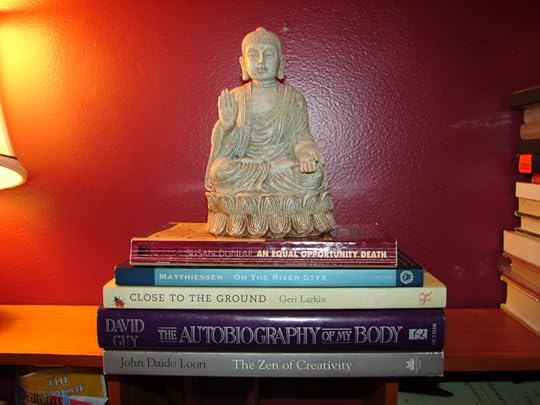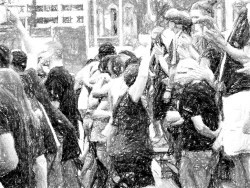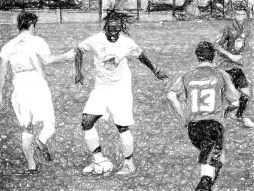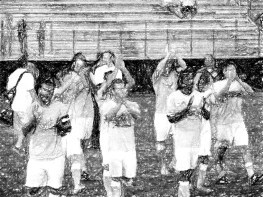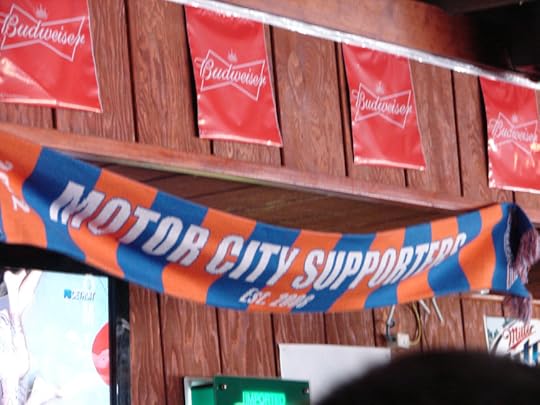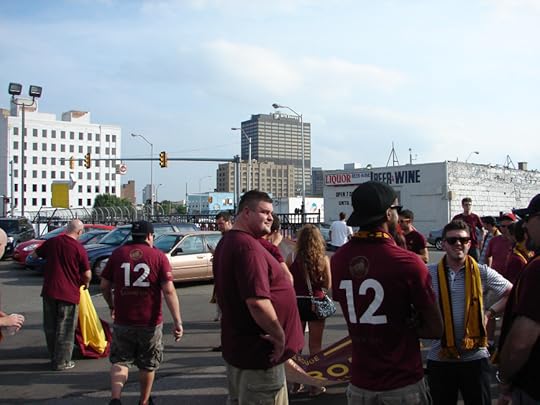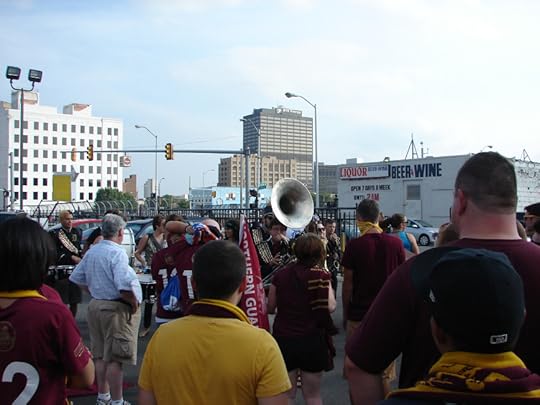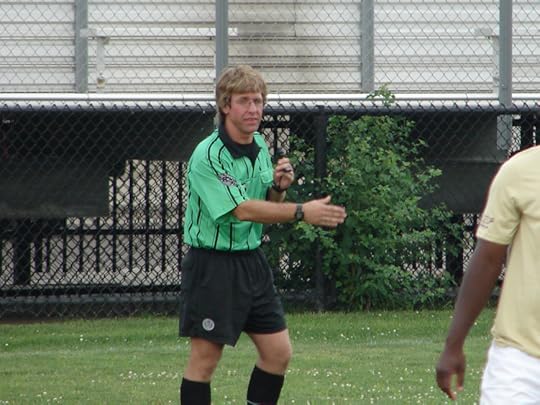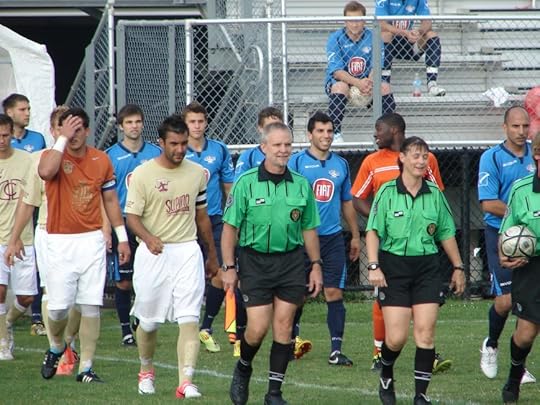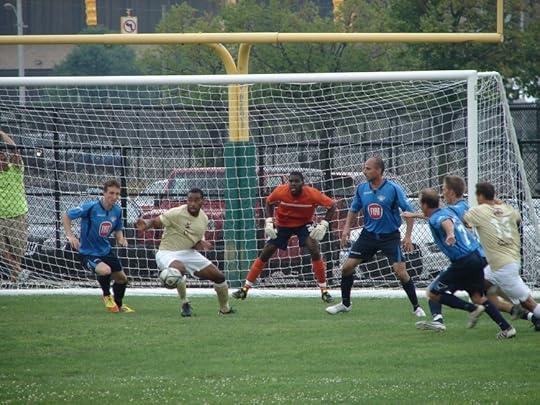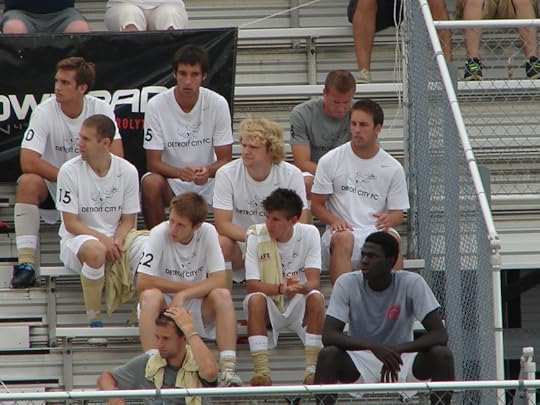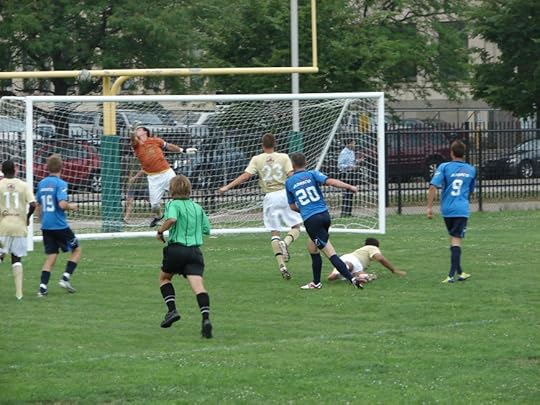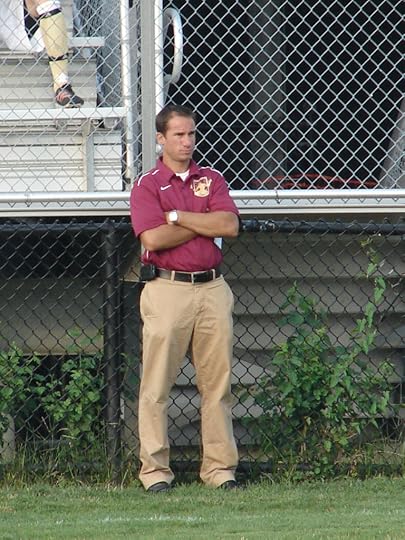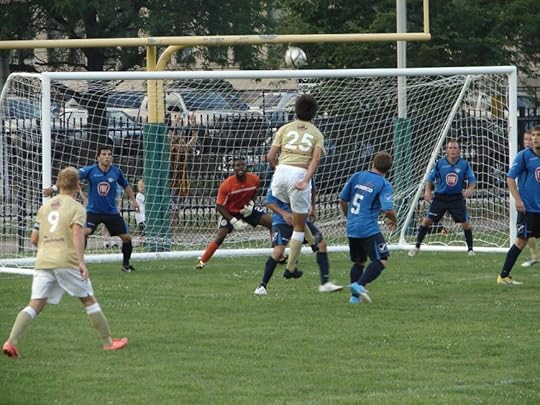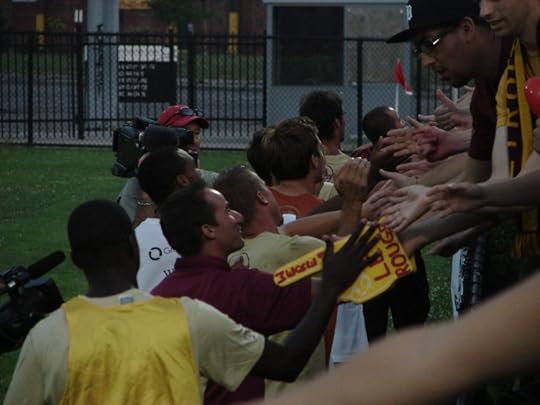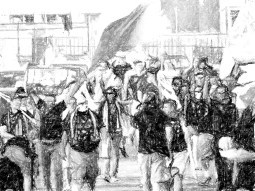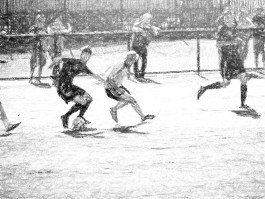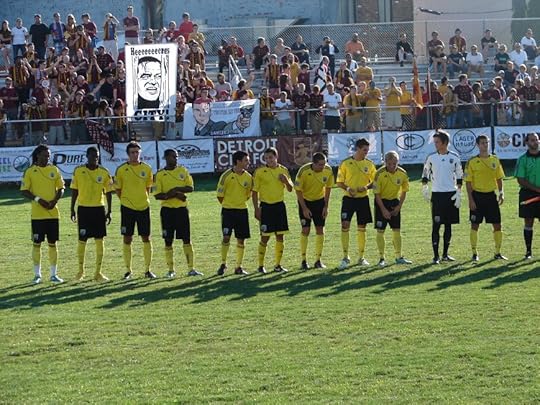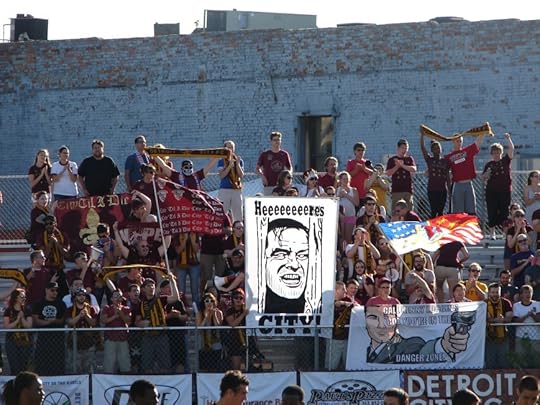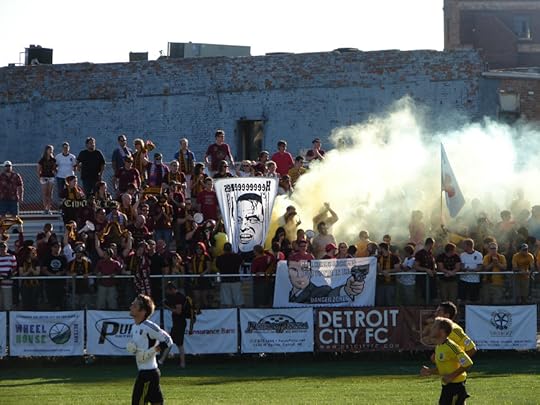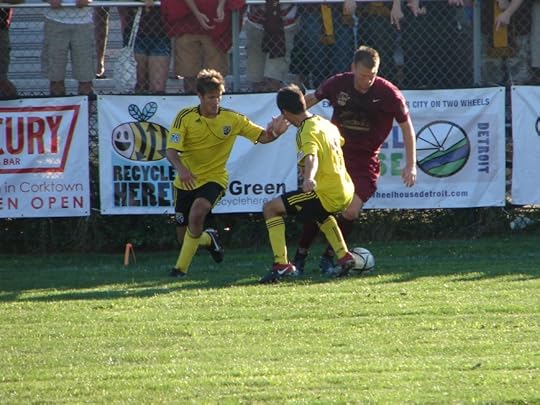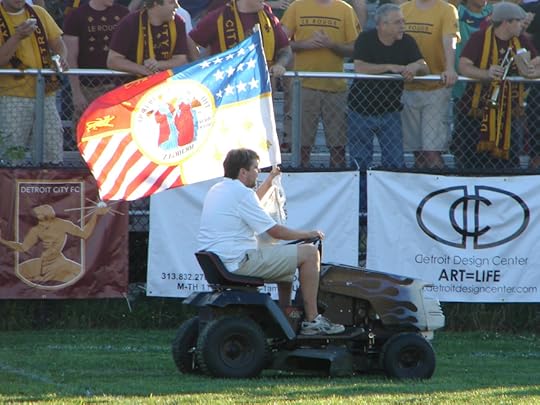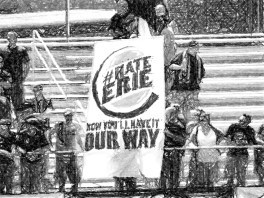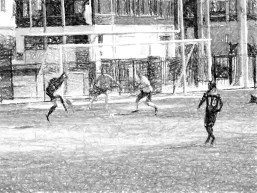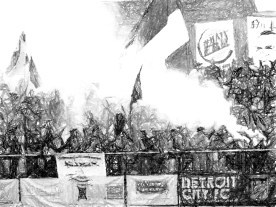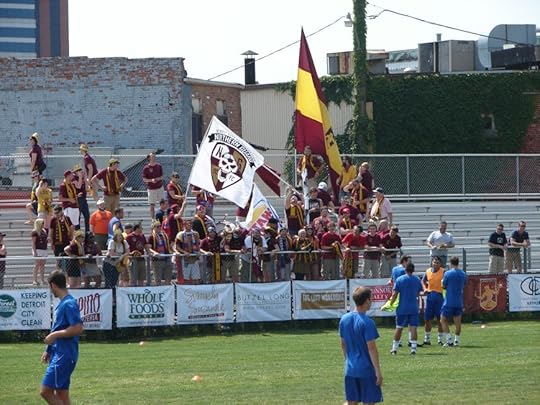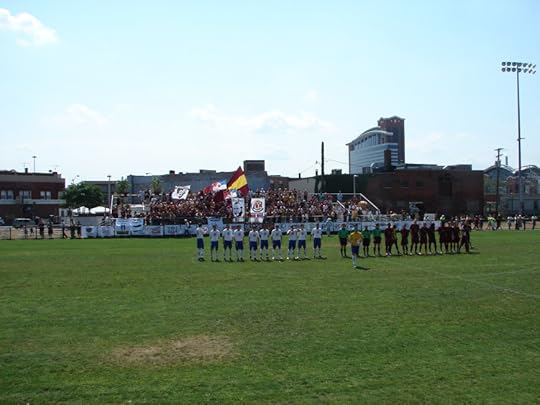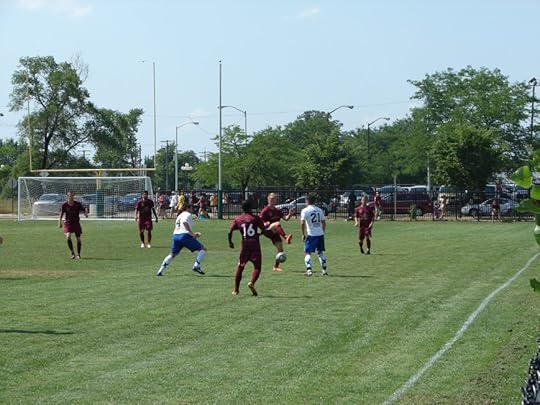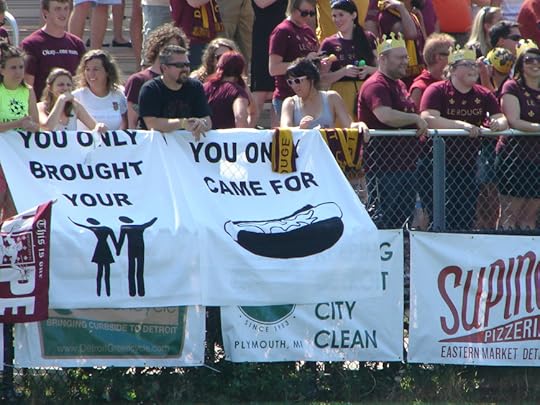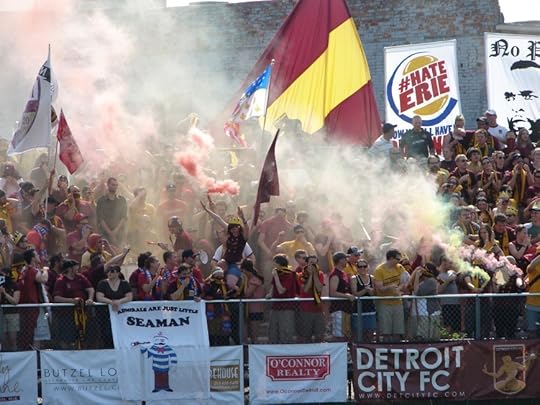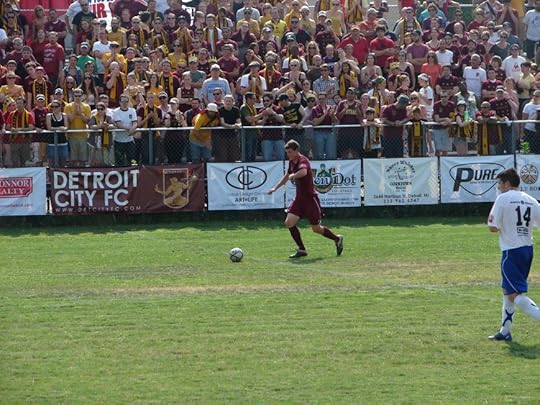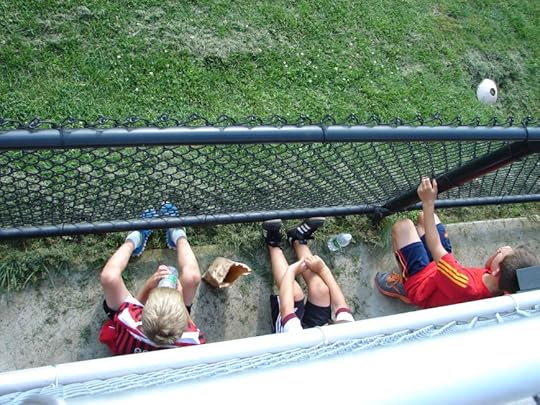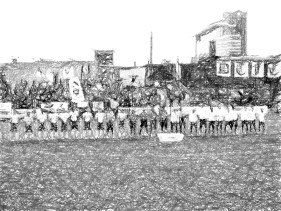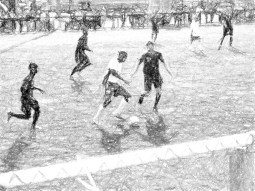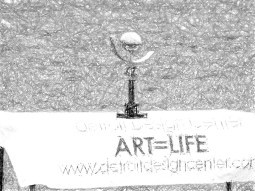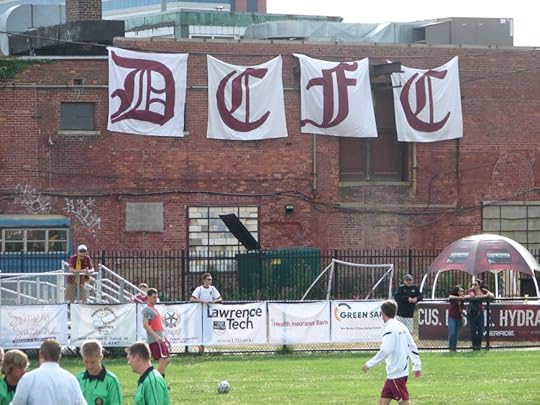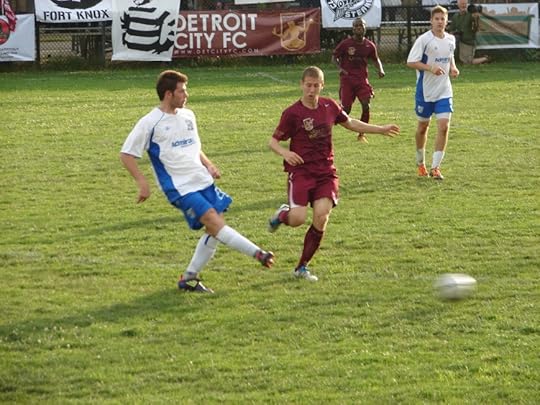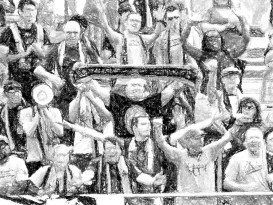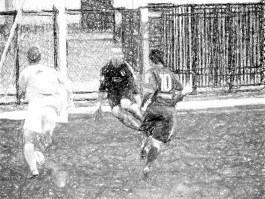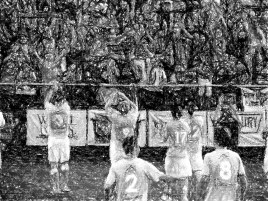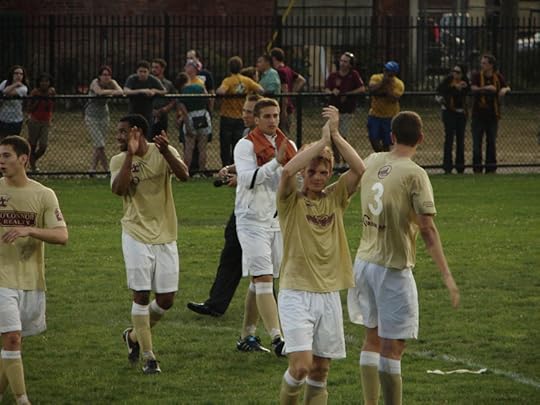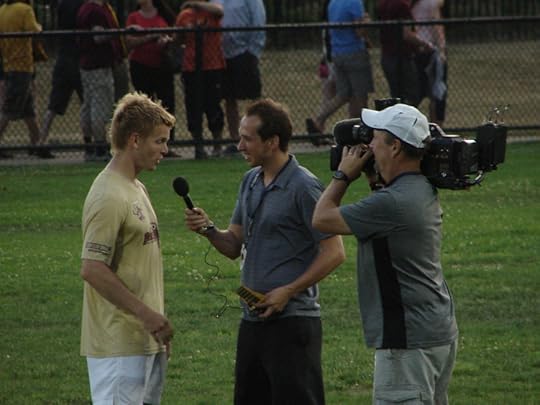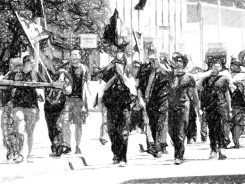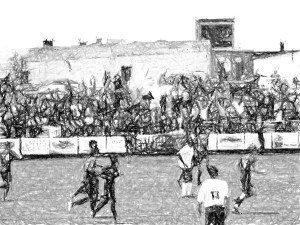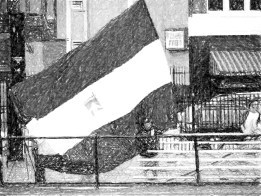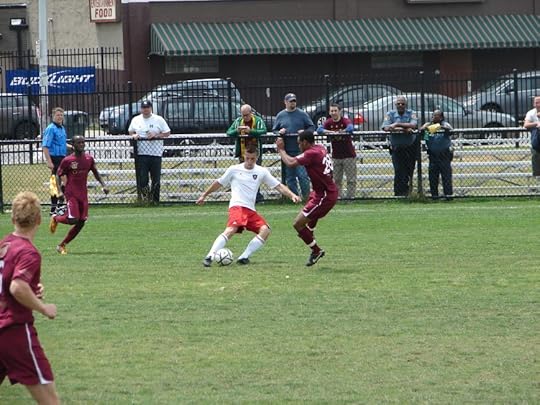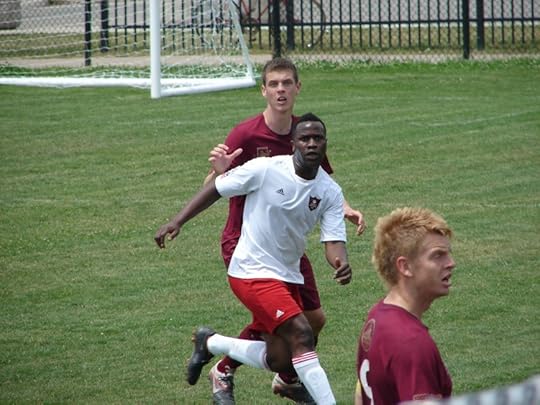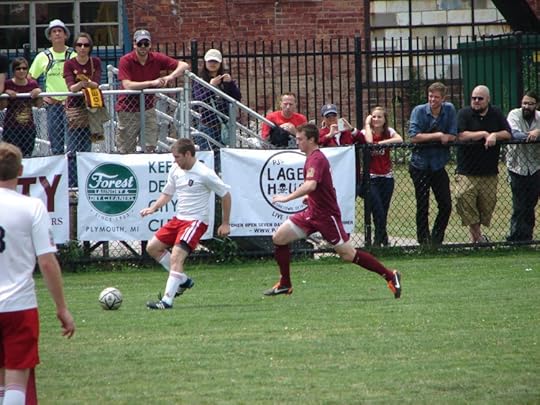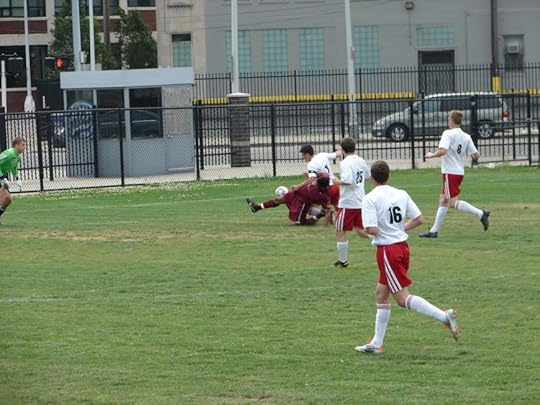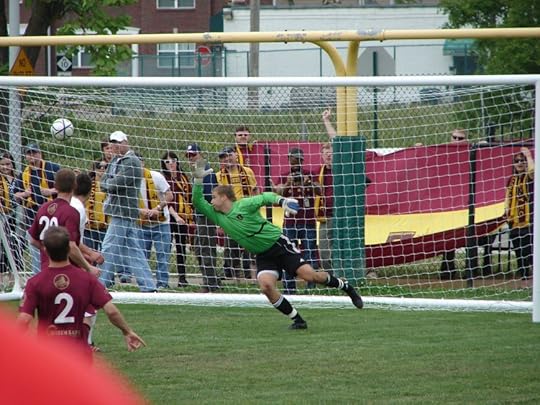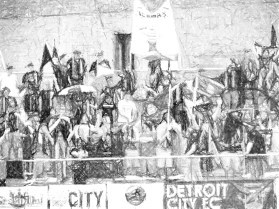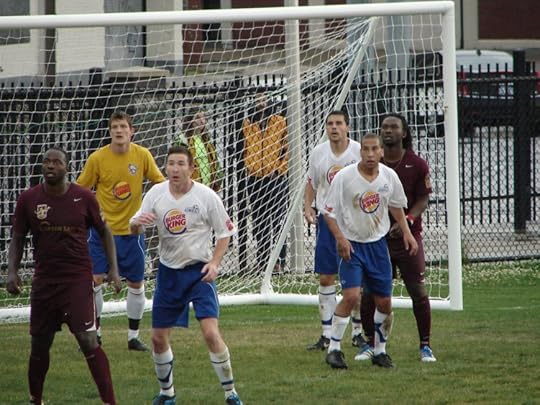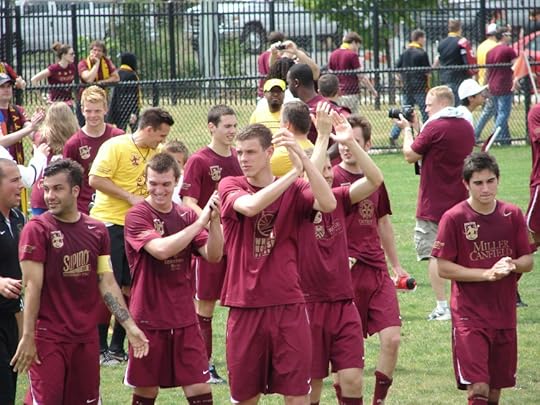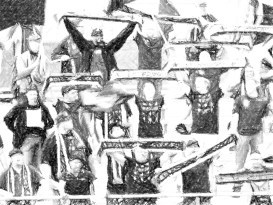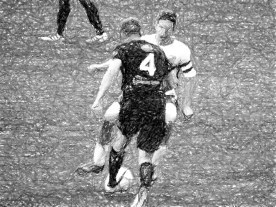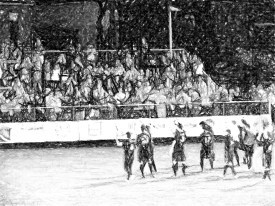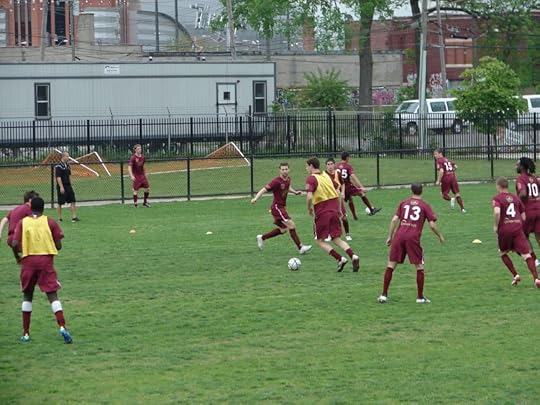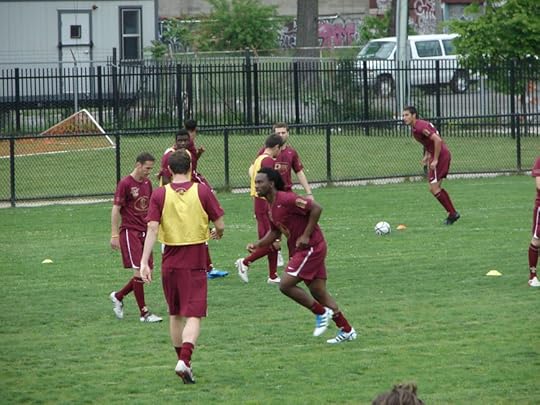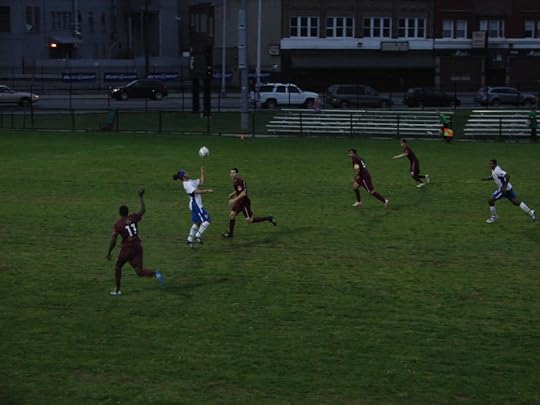Michael Kitchen's Blog, page 22
August 6, 2015
2013 Season Summary
The 2013 Season
The Invincibles
12 Games played; 11 Won, 1 Draw, 0 Lost
First Place, NPSL Midwest Great Lakes Division
2013 Rust Belt Derby Winner
I am writing this a couple weeks after the 2015 season has come to a close. And though each season has progressively become more fun and exciting, the 2013 season was the most memorable. This season kicked the team and NGS into second gear, taking it to the next level of legendary status.
Le Rouge went the season undefeated, capturing first place in the Great Lakes Division, which allowed them to host the playoffs.
It provided for the arrival of a local team that tried to capitalize on the rabid supporter base of DCFC, and failed, becoming known as Sharta – the disease.
It had the classic match played in a downpour.
It saw our first wedding on the pitch!
It solidified the disdain of our first real nemesis.
We had our first special jersey auction to raise funds for charity.
It had it’s surprising special moment when Le Rouge players entered the Supporters’ Section at the conclusion of their last regular season home match.
 And then there was the night were it all got a little weird.
And then there was the night were it all got a little weird.
It was the season that increased regular season attendance to 1,484 per match, with an additional 2,600 attending the Great Lakes Division semi-final match on July 13th.
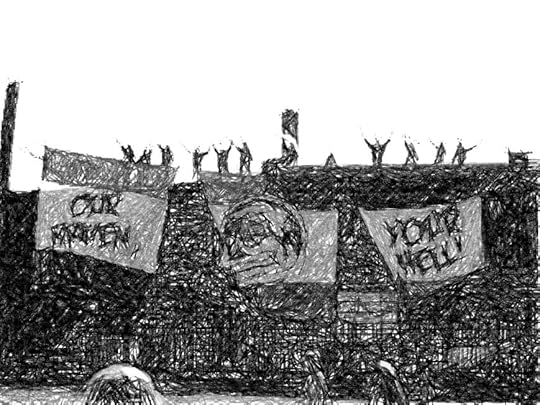 And this was the season I became a season ticket holder, my allegiance sworn to this team now.
And this was the season I became a season ticket holder, my allegiance sworn to this team now.
The 2013 matches are as follows:
May 12, 2013: at FC Sparta Michigan.
May 17, 2013: AFC Cleveland.
May 25, 2013: Zanesville Athletic FC.
May 31, 2013: FC Sparta Michigan.
June 9, 2013: Erie Admirals.
June 14, 2013: Zanesville Athletic FC.
June 18, 2013: Columbus Crew Super 20s (friendly).
June 23, 2013: FC Buffalo.
July 13, 2013: AFC Cleveland (Great Lakes Division Semi-Final).
July 14, 2013: Erie Admirals (Great Lakes Division Final).
July 17, 2013: Windsor Stars (friendly).


July 31, 2015
Book review: Books I’ve recently read all have one thing in common
This book review covers five books which I’ve recently completed reading. At first, the common thread was unintentional. But after discovering that I was in the middle of reading three books by authors who are Buddhist, I added two more.
Just because they are Buddhist authors, that does not necessarily mean that the topics are Buddhist. But in this case, a couple of them are.
 In 2013, my first Zen teacher, P’arang Geri Larkin, wrote Close to the Ground: Reflections on the Seven Factors of Enlightenment (Rodmell Press). Struggling with my commitment of spending Sundays in Detroit, either at Still Point Zen Buddhist Temple’s service, or providing service at Cass Park with Friends and the Forgotten Worker, a collection of many different circles of friends, groups, unions and political interests to feed and provide for the poor living in the Cass Corridor of Detroit, I chose to read this as a supplement. It came in quite handy.
In 2013, my first Zen teacher, P’arang Geri Larkin, wrote Close to the Ground: Reflections on the Seven Factors of Enlightenment (Rodmell Press). Struggling with my commitment of spending Sundays in Detroit, either at Still Point Zen Buddhist Temple’s service, or providing service at Cass Park with Friends and the Forgotten Worker, a collection of many different circles of friends, groups, unions and political interests to feed and provide for the poor living in the Cass Corridor of Detroit, I chose to read this as a supplement. It came in quite handy.
Taking the seven factors of enlightenment from the Pali Canon, Larkin provides a chapter on each with a series of dharma talks which flow seamlessly together, providing a practical understanding of each. The seven factors are:
Mindfulness: Attention to what is happening now.
Investigation of phenomenon: Curiosity about ourselves and the world we live in.
Energetic effort: Cultivating a high energy for life.
Ease: Being free of resistance.
Joy: The sweet feeling that everything is okay.
Concentration: Mindfulness focused on a specific task.
Equanimity: Calmness of mind and temper. Everything comes and goes in life.
For me, reading this book was a refreshing reminder of what works in my life. And the timing of some of it was incredible. I was reading the chapter on the investigation of phenomenon, questioning the source of my thoughts and beliefs as the chatter on Facebook focused on the United States Supreme Court decision in favor of gay marriage and of the nature and symbols of racism after a white gunman open fired in a black church in South Carolina, killing nine. I was reading the chapters on ease and joy when, for the first time since I’ve entered the Michigan Bar Journal Short Story Contest, my submission did not make the list of finalists. I was reading the chapter on concentration as I was revising a 13,640-word short story that is circulating amongst potential publishers. And I was reading equanimity after a shocking loss in a court room trial, which hurled me into a state of heavy self-criticism. Through all this, the right teacher was right there at the right time. A testament to how well this book applies to every day life.
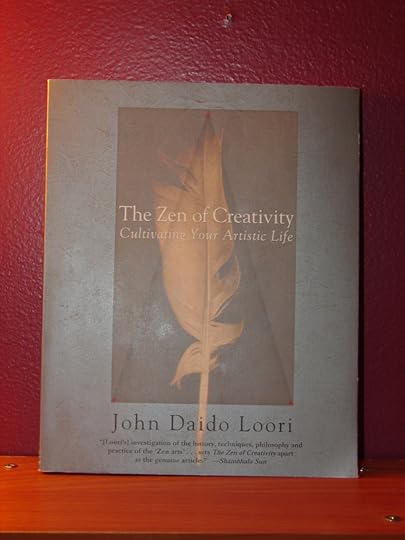 The late John Daido Loori was one of my early influences into Buddhism. He founded the Zen Mountain Monastery in New York. I subscribed to the monastery’s quarterly journal – Mountain Record: The Zen Practitioner’s Journal – for a few years in the mid-1980’s. The Zen of Creativity: Cultivating Your Artistic Life (Ballantine Books, 2005) has been on my radar for a number of years. This spring, seeing it on the shelf at Still Point, I started thumbing through it again. It was there again the next week, and finally, the third week I decided it was time to purchase and read it.
The late John Daido Loori was one of my early influences into Buddhism. He founded the Zen Mountain Monastery in New York. I subscribed to the monastery’s quarterly journal – Mountain Record: The Zen Practitioner’s Journal – for a few years in the mid-1980’s. The Zen of Creativity: Cultivating Your Artistic Life (Ballantine Books, 2005) has been on my radar for a number of years. This spring, seeing it on the shelf at Still Point, I started thumbing through it again. It was there again the next week, and finally, the third week I decided it was time to purchase and read it.
The book is broken down into four sections. Part One is the story of Loori’s journey to Zen. Part Two presents the practices which guide the artist to a new way of seeing and creating. Part Three explains how the Zen aesthetic points to basic truths about how to live freely. The qualities of simplicity, mystery, spontaneity, and suchness, are embodied in both Zen and the arts. Part Four brings the book full circle reflecting Loori as an artist and spiritual seeker, and how the creative and spiritual journey never ends.
Photography was the strong artistic expression for Loori, so reading this both as a writer and a photographer kept me interested. Loori quoted his mentor, Minor White, about photography, which rang true to me. It is much the way I approach Detroit City FC games that I shoot.
The state of mind of the photographer while creating is blank…[but] It is a very active state of mind really, a very receptive state of mind, ready at an instant to grasp an image, yet with no image pre-formed in it at any time.
Throughout this book, there are nuggets of deep truths for artists. But it doesn’t feel like a self-help, positive-thinking, cheerleading book for writers like some I’ve encountered. The deliberate process which Loori presents holds meaning. For example, when he writes, “It is important to trust this and to trust the process. Trust yourself. Your way of experiencing the world is unique. And what you’re trying to do is give voice to this unique experience,” nothing about it feels like someone saying something nice out of obligation or in order to sell more books. Everything leading up to it adds to its credibility, giving one (at least me) a sense that, “Yeah, he really means this. I need to trust myself.”
This book doesn’t go back to the bookshelf of writing reference books near my desk, but rather on the small shelf above my desk, where it is easily accessible when I need the reminders and inspiration.
Like anything that one makes well with one’s own hands, writing good nonfiction prose can be profoundly satisfying. Yet after a day of arranging my research, my set of facts, I feel stale and drained, whereas I am energized by fiction. Deep in a novel, one scarcely knows what may surface next, let alone where it comes from. In abandoning oneself to the free creation of something never beheld on earth, one feels almost delirious with a strange joy. – Peter Matthiessen, The Paris Review No. 150, Spring, 1999.
I’ve often felt that as a writer and as a Zen Buddhist, I needed to read and like Peter Matthiessen’s work. Born in New York City in 1927, Matthiessen created The Paris Review in 1951, which has become my personal favorite literary journal. His life’s work included ten novels, the collection of short stories above, and over twenty works of nonfiction. He has won a National Book Award in both fiction (Shadow Country, 2008) and nonfiction (The Snow Leopard, 1980). His 1983 book, In the Spirit of Crazy Horse, about the American Indian Movement and the 1975 shoot-out at Pine Ridge in which two FBI agents and a young Indian were killed, brought litigation against him and Viking Press by FBI Agent David Price and South Dakota Governor, William Janklow, for libel. The book’s publication was halted until 1993 after both cases were dismissed and appeals were denied by the US Supreme Court and upheld by the South Dakota Supreme Court. Matthiessen became an ordained Zen Buddhist Priest in 1981 under Maezumi Roshi at the Greyston Center of the Zen Community of New York. He died in April, 2014.
I remember, back in the 1980’s, picking up Race Rock, Matthiessen’s first novel. For whatever reason, it did not draw me in. Hoping that my sensibilities had changed, I decided to return to Matthiessen’s work with this collection of short stories. On average, I liked the stories I read (I haven’t yet finished the final two stories). What I discovered about myself as a reader is that I am more interested in characters than environments. For example, my favorite story of the collection is Travelin’ Man, which was written in 1957 about Traver, a black man who escaped from prison and was running and hiding along the Carolina coast from his jailers who were hunting him. The language is harsh (as it is in the earlier stories, using the language of that time in the South, in particular the epithet for African Americans), and the situation and the character kept me in it. On the other hand, Matthiessen was also a wildlife writer and naturalist. On the River Styx – one of the two I had not read – opened with the following paragraph:
On the pale flats the lone trace of man was a leaning stake marking some lost channel that a storm or shift of current had filled in. On the end of the stake perched a ragged cormorant, its drying wings held wide in a black cross against the wind. The archaic bird, the rampant mangroves, the hidden underwater life raising ghostly puffs from the white marl dust of ages of dead creatures, deepened Burkett’s sense of solitude, of pointlessness. Earlier that day they had seen a silver horizon off the the west, where the Ten Thousand Islands opened out onto the Gulf, and this window of light, for a little while, had dissipated a vague dread that had been gathering for days.
This just doesn’t move me, I’m afraid, even though I think it’s supposed to.
I do have an interest in reading the Watson trilogy – probably as the revised, single edition Shadow Country, and In the Spirit of Crazy Horse.
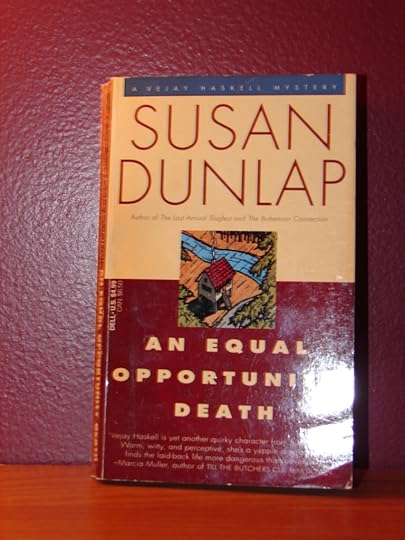 Susan Dunlap has been a Zen Buddhist since the first time she walked into a zendo in the 1970’s. A founding board member of the Sisters in Crime, an organization dedicated to supporting women mystery writers, Dunlap has created four series characters and has written twenty-four novels in the genre.
Susan Dunlap has been a Zen Buddhist since the first time she walked into a zendo in the 1970’s. A founding board member of the Sisters in Crime, an organization dedicated to supporting women mystery writers, Dunlap has created four series characters and has written twenty-four novels in the genre.
This is the first in a series of three Veejay Haskell novels. At first blush, I thought the character was Indian. But Veejay is a nickname for Veronica. It is a cozy, in that Veejay is a meter reader for the electric company, and she has to solve the mystery of Frank Goulet’s death. Goulet was found shot dead in his bar, and Veejay was the last person to see him alive (or second to last, to be more accurate). With the sheriff suspecting her, she is incumbent upon unraveling the mystery before the cuffs are fastened to her wrists.
It was a quick read, a relative easy read, which the genre is apt to be. I liked the book enough to see my way through to the end. Though there are two more books in this series, I’m more interested in delving in the Darcy Lott series, which I understand is more openly Buddhist.
I read this book in the early 1990’s, then again sometime in the 2000’s. The beat-up, paperback edition had survived moves from Novi, St. Clair Shores, and Harrison Township. In November, 2012, I was in John King Books in Detroit, and came upon first editions of this, and David Guy’s earlier works; The Man Who Loved Dirty Books (New American Library, 1983) and Second Brother (New American Library, 1985). His fourth novel, Jake Fades was published by Trumpeter Books, an imprint of Shambhala Publications in 2007. I decided it was time to read it again.
I really should do a separate entry on him. Guy, a Buddhist and writing instructor at Duke University, is a writer I have enjoyed. At least three of his four novels I have. Second Brother I cannot say I enjoyed only because I have not yet read it.
The Autobiography of My Body (Dutton, 1991) is about Charles Bradford, a writer surviving a divorce, returning home to Pittsburgh because his father, whom he refers to as The Senator, is recovering from a recent heart attack. His mother, to whom he refers to as The Duchess, is concerned about her husband’s health, and links it to a situation at his firm – he is a prestigious Pittsburgh lawyer. Charles stays with his sister, Helen, a lesbian, who he is closer to than their younger brothers who followed the Senator into the practice of law.
The homecoming is a recollection of his sexual discovery, a compelling drive which defines his life’s compass. While in Pittsburgh, he connects with Andrea, a feminist and political activist from his past, who also experienced the end of her marriage. Passion, emotions, and family dynamics give Charles an opportunity to examine the autobiography of his body, and to recall and experience sexual encounters, some of which sway into the fetish realm.
This cluster of books I’ve recently read all resonated with me. Was it because they were all Buddhist writers? That could definitely be the case with Close to the Ground and The Zen of Creativity. But the other three did not express Buddhist locations or characters, or even indicate that the writers themselves were Buddhist. As Charles Johnson wrote in the foreword to the anthology of Buddhist short stories, Nixon Under the Bodhi Tree and Other Works of Buddhist Fiction (Wisdom Publications, 2004), “The Buddhist experience is simply, the human experience.”


July 24, 2015
July 18, 2012: Windsor Stars (friendly)
July 18, 2012
DCFC 0, Windsor Stars 0
After a 2-1 loss against AFC Cleveland in the semi-final round of the playoffs in Erie, the 2012 season closed with this friendly against the Windsor Stars. The attendance was 1,032 fans, meaning that every home game in the inaugural season exceeded 1,000 fans – this in a league where teams tend to draw 500 fans on average.
This was also my first adventure into the Northern Guard Supporters’ ritual of meeting at Harry’s Bar in Detroit, then marching to the stadium from there.
I must have been the first person to arrive because the parking lot attendant asked if there was a soccer game this evening. I walked in and dined on the first floor. A couple from Portland, Oregon came in – members of the Timbers Army, the supporters group of the Portland Timbers in Major League Soccer – and asked me about the NGS. I told them this was my first time meeting up with them. The hostess came over and told us that the Supporters met upstairs. Doh.
After finishing my meal, I ascended to the upper level of Harry’s and hung out. I overheard a conversation between a guy who was attending his first game and a guy who had been to most of the games, having driven down from Saginaw. He burned a vacation day for tonight’s match (it was a Wednesday evening) and had called in sick for last week’s game against the Crew Under-20’s.
Other than that I didn’t mingle. Bars aren’t my scene, and those gathered seemed to be all grouped together with friends they had met during the season, engaging in their own conversations. The call went out, and we all went down to the parking lot to march to the stadium. We were then greeted by the Detroit Party Marching Band. They played a number just for us, then marched with us to the stadium. That was quite cool. Then, they sat in the supporters’ section and played between the chants.
I remained on the supporters’ side, photographed and enjoyed the camaraderie. The game meant nothing in the grand scheme of things, however the thrill and the support didn’t waver from what occurred during a regular season match.
Harry’s
Detroit Party Marching Band
The game had the potential of being called fairly.
After all, the ref wore glasses.
Action.


July 23, 2015
July 11, 2012: Columbus Crew U-20’s (friendly)
July 11, 2012
Detroit City FC 1, Columbus Crew U-20’s 3
CREW Jordan Tyler 24′
CREW Matt Walker 42′
CREW Matt Walker 79′
DCFC Wade Allen 90+’
On the cusp of their first playoff appearance, Le Rouge host the Columbus Crew U-20 team in a friendly that draws 1,142 City faithful.
Pre-Game:





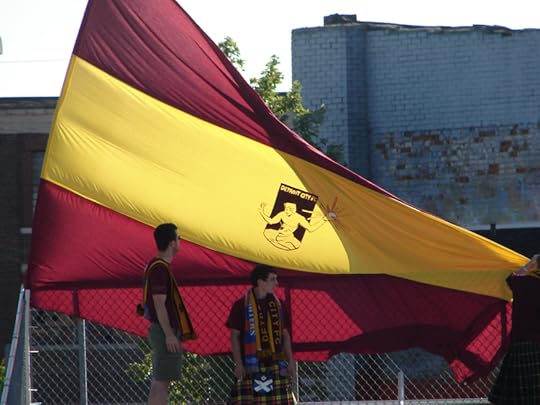

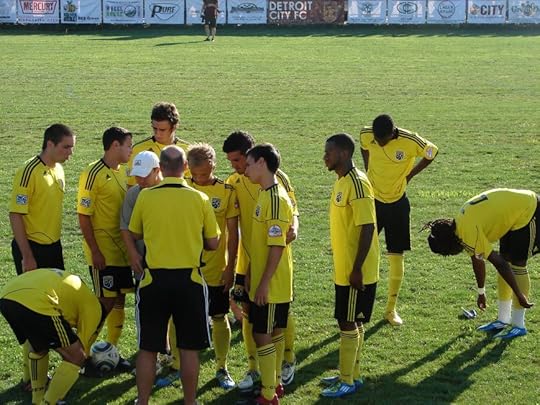 Starting Eleven.
Starting Eleven.Action.


July 21, 2015
July 1, 2012: Erie Admirals
July 1, 2012
Detroit City FC 1, Erie Admirals 2
ERIE Erik Beattie (Stephen Mahon) 8′
DCFC Cyrus Saydee 35′
ERIE Ryan Johnstone (Shane Howard) 72′
Fifteen hundred fans attended this must-win match. The team traveled to Buffalo the night before, earning a 4-0 win, then came home for this match where the temperature was close to triple digits. Both Erie and Le Rouge were sitting at the top of the league with 20 points each. Unfortunately, Le Rouge lost their first home match and the chance to host the Great Lakes Division playoffs.
Pre-Game.
Action.


July 18, 2015
June 23, 2012: AFC Cleveland
June 23, 2012
Detroit City FC 1, AFC Cleveland 1
DCFC Stefan St. Louis (Keith Lough) 23′
AFCC Thomas Schmitt 87′
A new attendance record of 1,743 witness the deciding match of the Rust Belt Derby. The Supporters of Detroit City FC, AFC Cleveland, and FC Buffalo established this derby amongst themselves and created a weighty trophy to be held by the supporters of the winning team. If Le Rouge won this match, they would claim it. A draw or AFC Cleveland victory would award the trophy to them. The 2012 Rust Belt Derby went to Parma.
Pre-Match
Let the game and smoke commence!
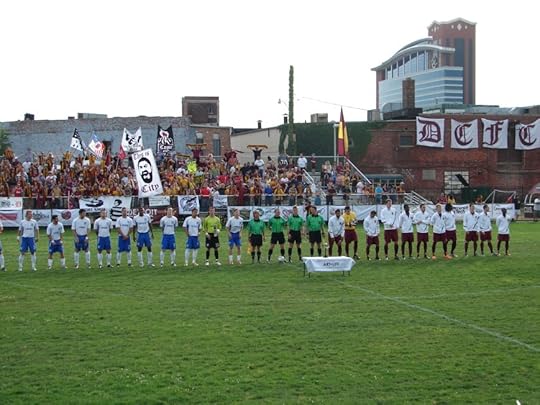

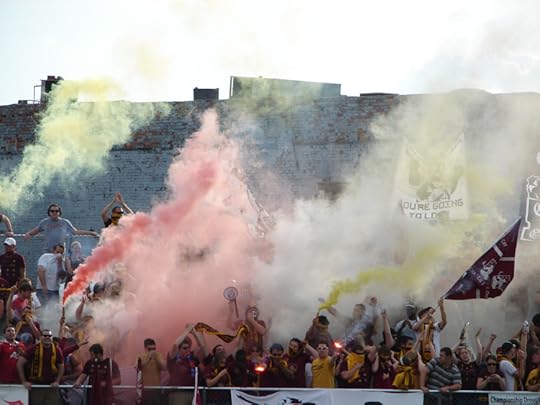
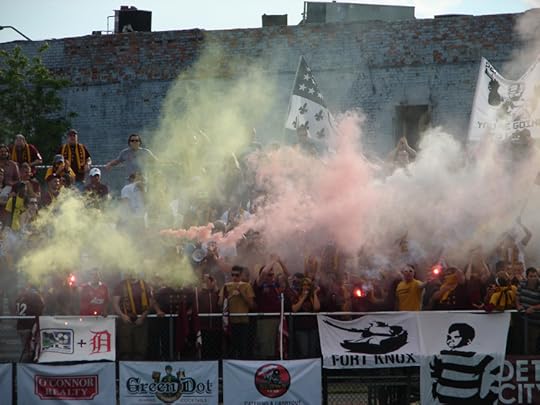 Action.
Action.


July 16, 2015
June 16, 2012: FC Buffalo
June 16, 2012
Detroit City FC 3, FC Buffalo 0
DCFC Keith Lough (Knox Cameron) 19′
DCFC David Dwaihy (Kyle Bethel) 69′
DCFC Kyle Bethel (Keith Lough) 90′
A new attendance record of 1,429 cheer on another clean sheet for Le Rouge.
Let’s get this party started.


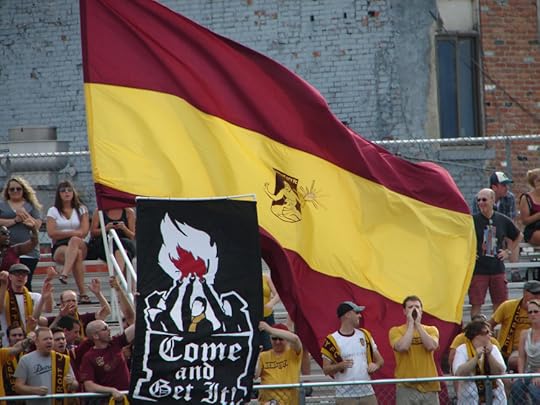

 The starting eleven.
The starting eleven.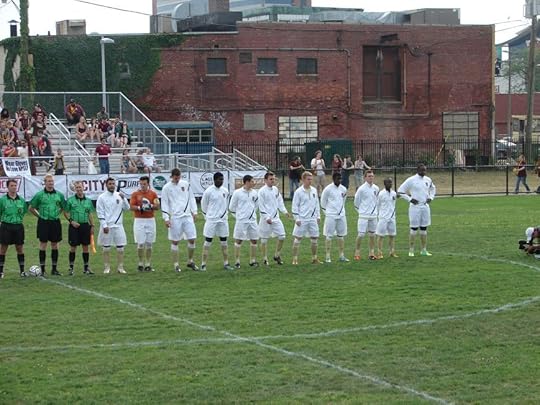




 The Situation Room: I believe this is the first visit
The Situation Room: I believe this is the first visitby an opposing team’s supporters’ group.
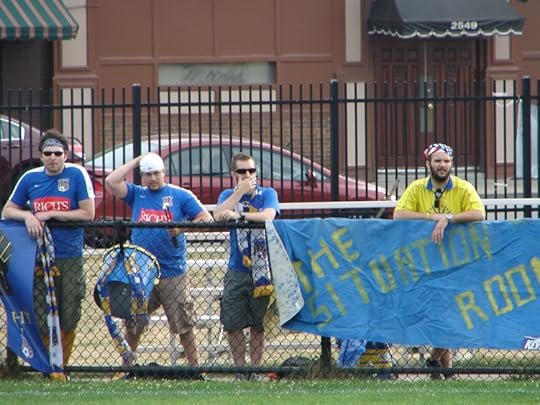 Action
Action

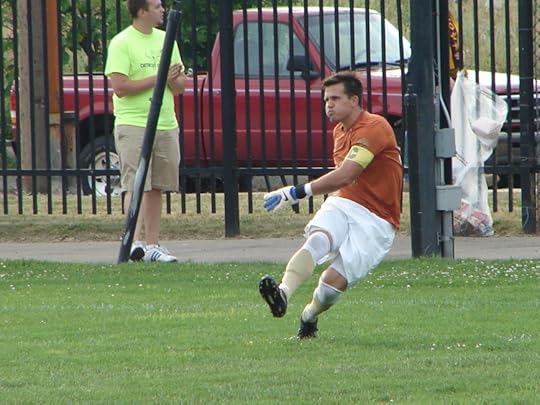
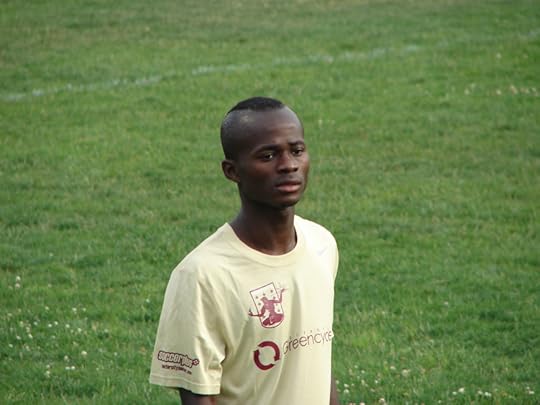



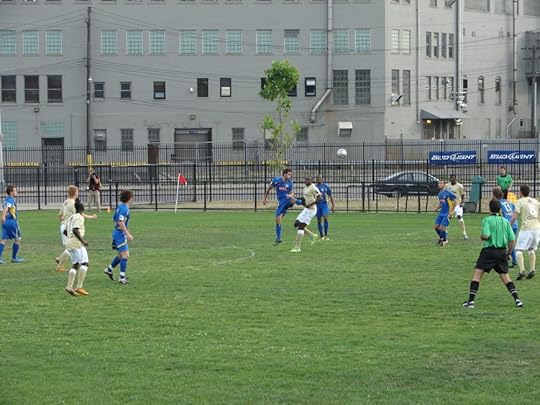
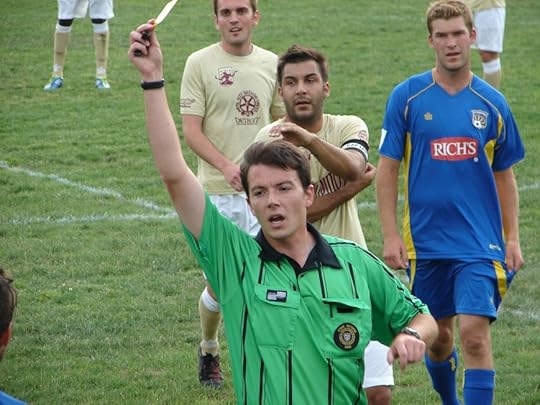

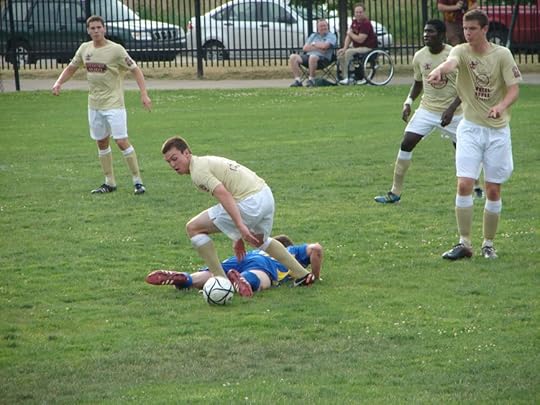

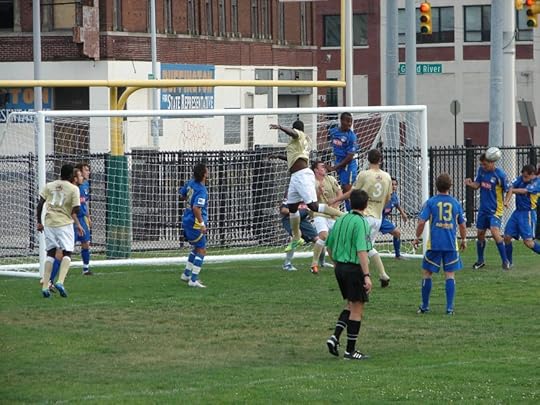
 One – Nil.
One – Nil.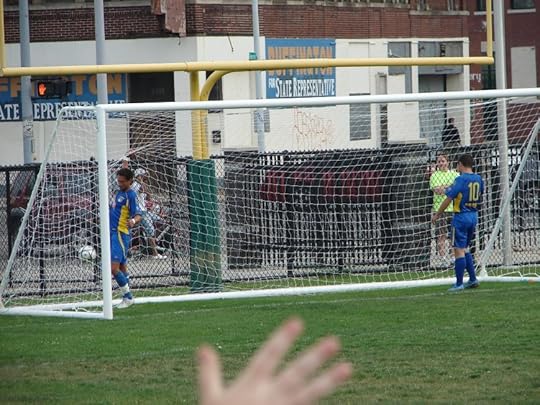

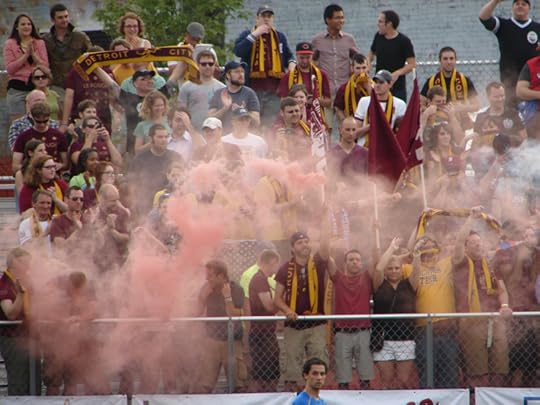 Action.
Action.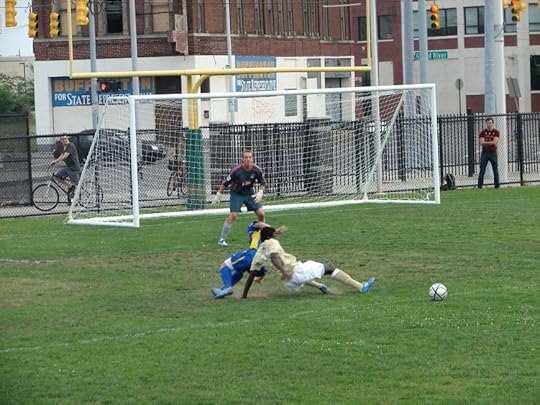
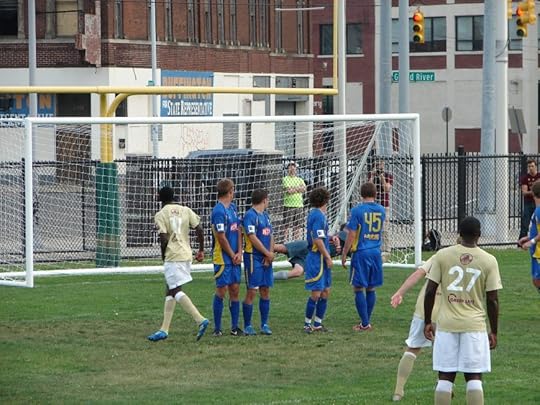

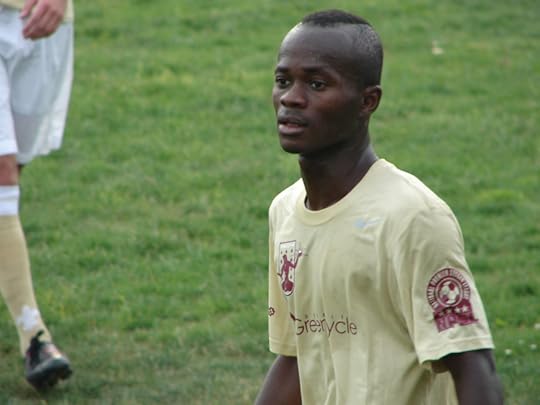





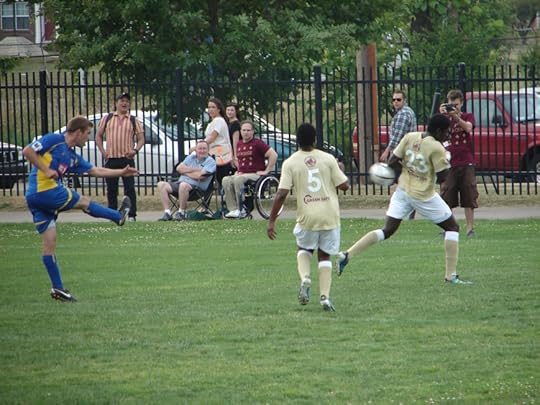


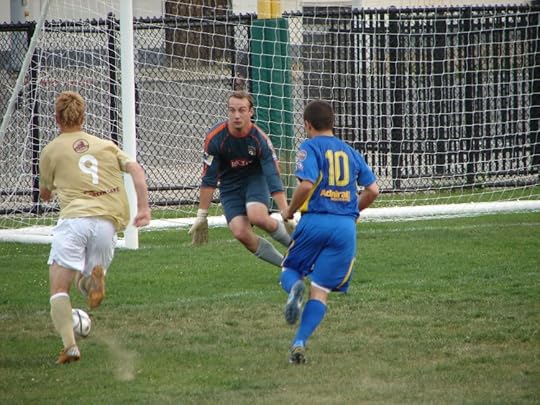


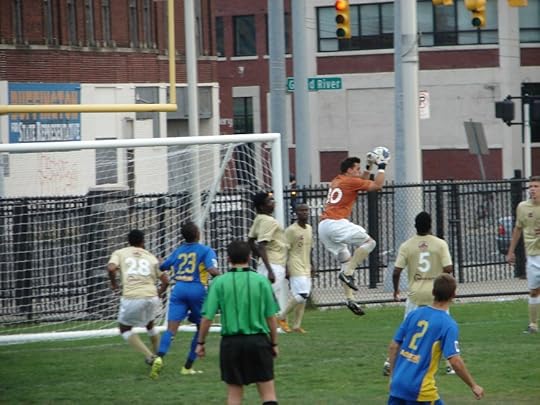

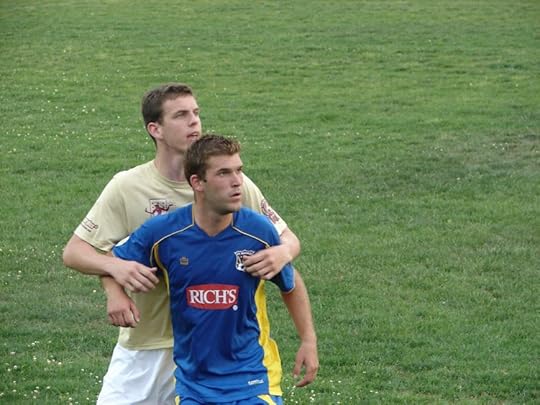
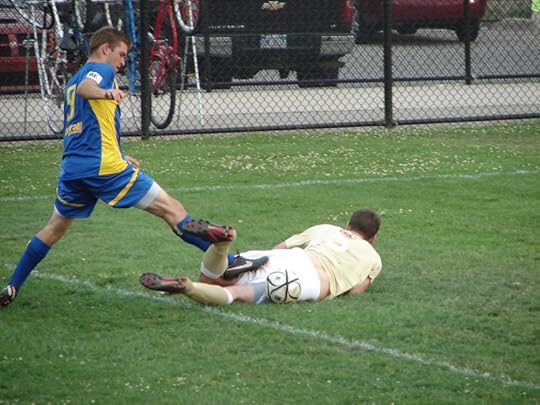
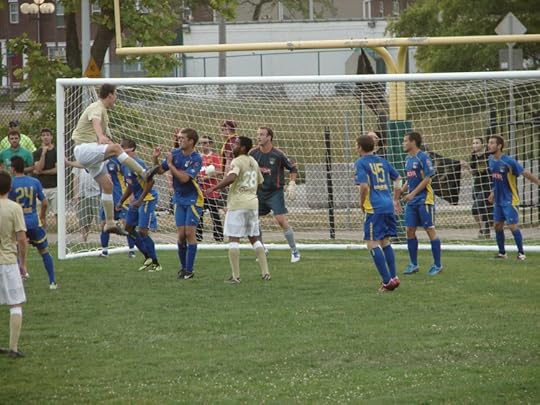




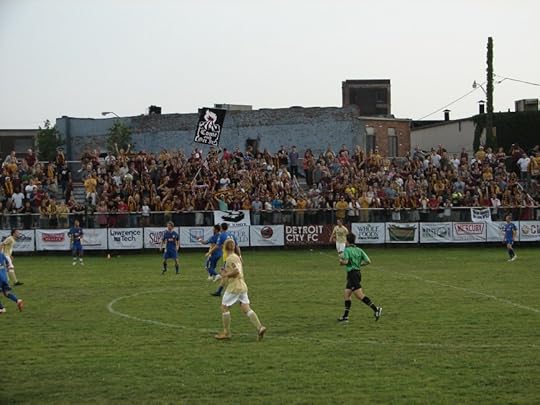
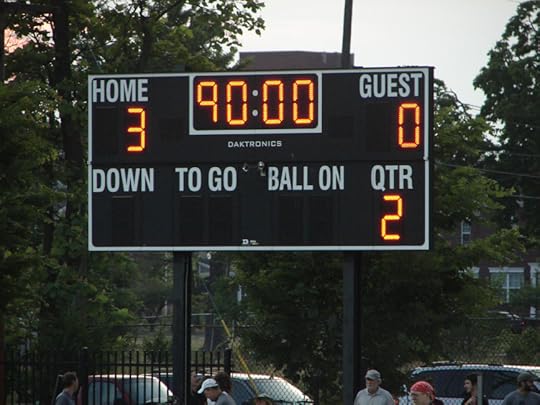 Post game wrap-up.
Post game wrap-up.

July 14, 2015
June 2, 2012: Greater Binghamton FC
June 2, 2012
Detroit City FC 4, Greater Binghamton FC 0
DCFC Kyle Bethel (Keith Lough) 18′
DCFC Kyle Bethel 33′
DCFC Knox Cameron (Cyrus Saydee) 57′
DCFC Cyrus Saydee (David Dwaihy) 78′
Another grand of supporters in the stands enjoy a lop-sided City victory. We had taken four points from Binghamton on their grounds with a 4-0 win on May 19th, and a Nil-Nil draw on May 20th. These three games are the only times that DCFC played against GBFC. In 2013, GBFC moved into the Northeast Region of the NPSL.
This game, I shot more video, capturing the action and sounds of the Le Rouge/Northern Guard Supporter experience.
Pre-Match
Northern Guard Supporters arrive and prepare to support.






 Starting line-up
Starting line-up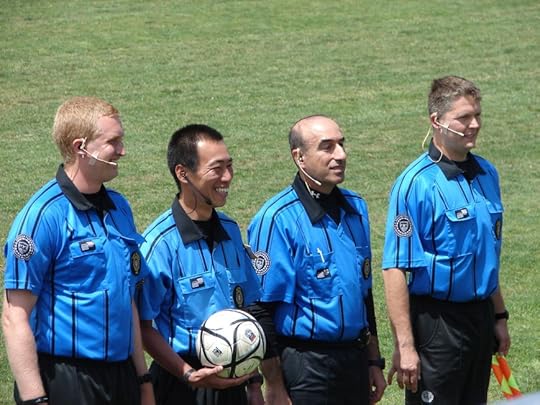

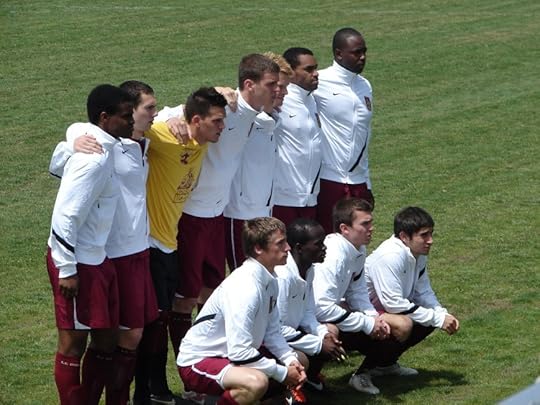 Action.
Action.




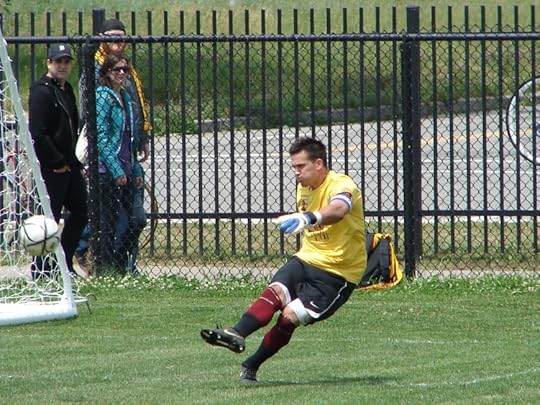




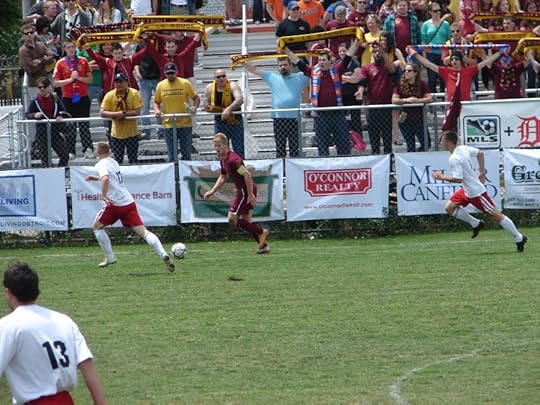 The first of the four.
The first of the four.

 Action.
Action.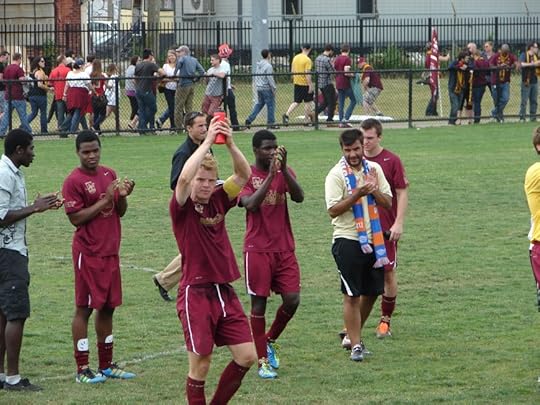 The Players:
The Players:Adam Bedell
 Latif Alashe
Latif Alashe Knox Cameron
Knox Cameron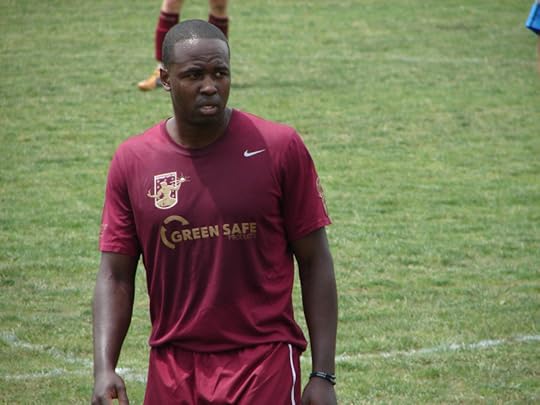 Kyle Bethel
Kyle Bethel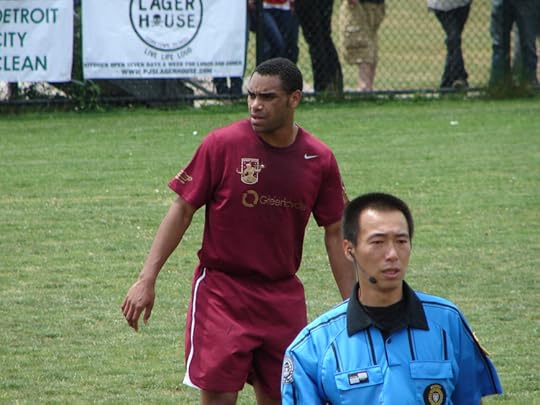 Keith Lough
Keith Lough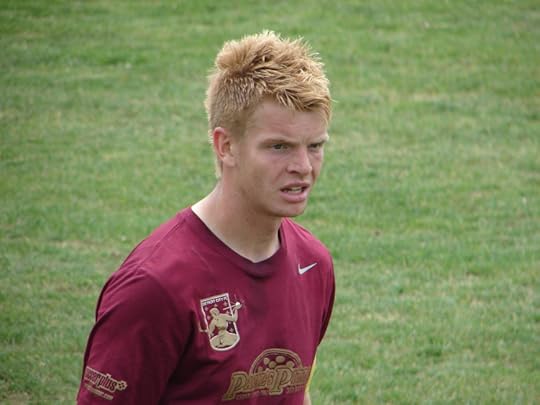 Jeremy Clark
Jeremy Clark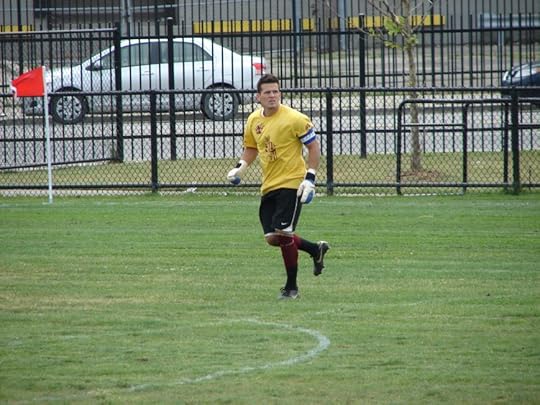 Wade Allen
Wade Allen Joey Dillon
Joey Dillon Cyrus Saydee
Cyrus Saydee


July 9, 2015
May 26, 2012: Erie Admirals
May 26, 2012
Detroit City FC 3, Erie Admirals 0
DCFC Knox Cameron (Keith Lough) 19′
DCFC Keith Lough (Tom Oatley) 35′
DCFC Kyle Bethel 83′
The first true test of support for Detroit City FC. A torrential rain hammered the fans early in the afternoon affair. But together, Supporters and team weathered the storm, putting three past the (Danny) Mudd between the Erie pipes.
Ominous clouds overhead won’t dampen the Supporters’ spirits.
And down it comes….







 Action.
Action.




 Knox Cameron puts it where Alejandro Moreno’s grandmother hangs her clothes.
Knox Cameron puts it where Alejandro Moreno’s grandmother hangs her clothes. And there was much rejoicing!
And there was much rejoicing!
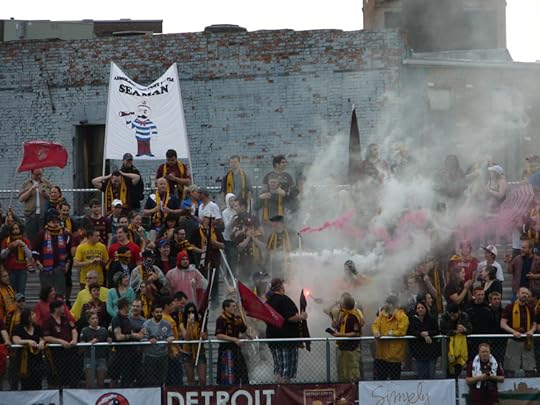 Keith Lough traps the ball then scores for a 2-0 lead.
Keith Lough traps the ball then scores for a 2-0 lead.
 More action…and it gets a little chippy.
More action…and it gets a little chippy.

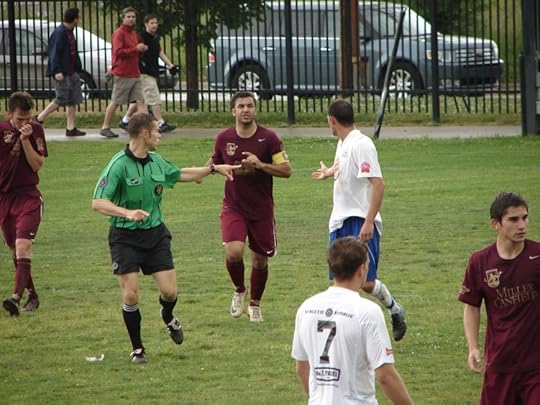

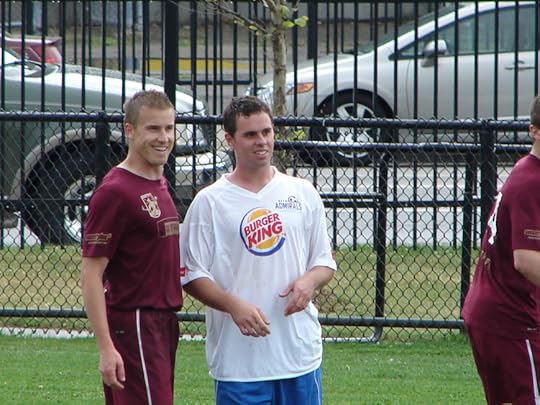







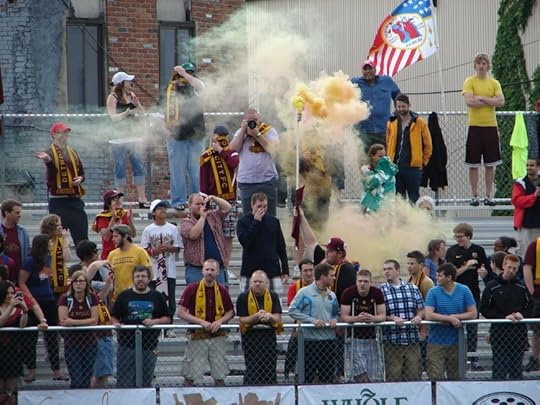






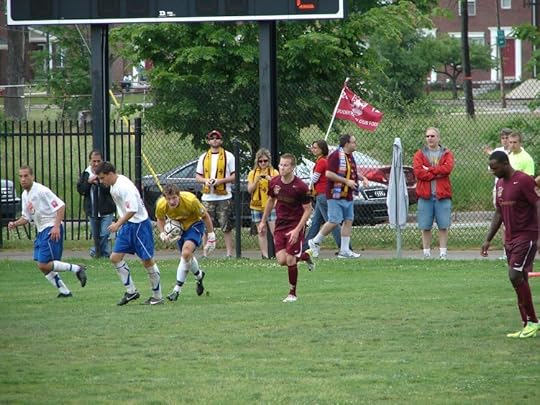


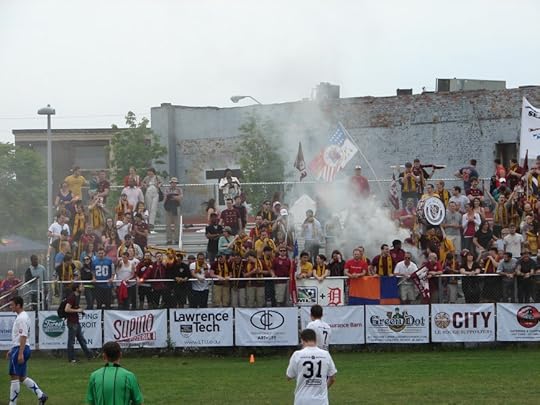








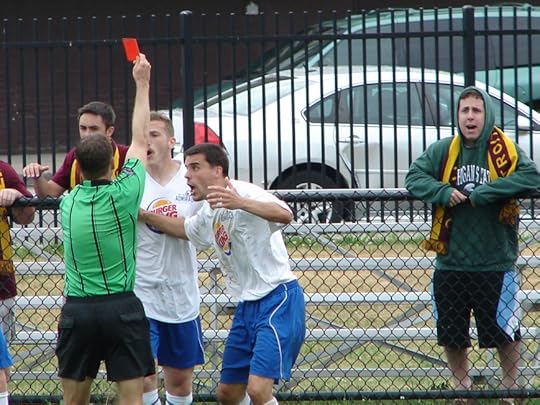
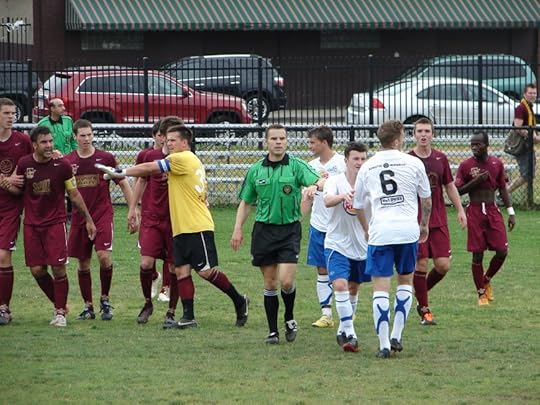
 Post-match. Appreciation given and received.
Post-match. Appreciation given and received.

July 5, 2015
May 12, 2012: AFC Cleveland
MAY 12, 2012
Detroit City FC 1, AFC Cleveland 1
DCFC Stefan St. Louis (Tom Oatley) 11′
AFC Vinny Bell 35′
A crowd of 1,072 fans ushered in Detroit’s new soccer team. It was also the debut of the Northern Guard Supporters.
Pre-Game:
The first march to the stadium:
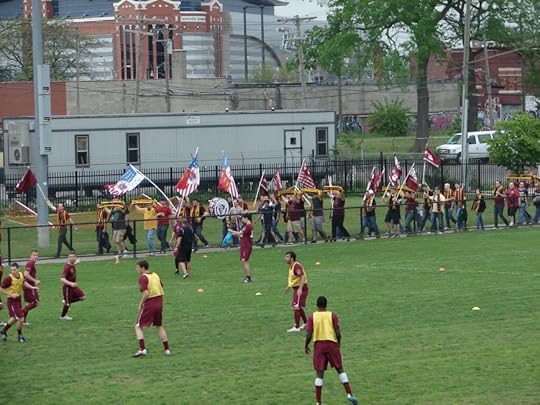







The starting eleven:

 The opening goal. The ball comes in to St. Louis, who puts it past Ben Yabrow, then runs to the Supporters’ Section.
The opening goal. The ball comes in to St. Louis, who puts it past Ben Yabrow, then runs to the Supporters’ Section.


And the first smoke from NGS to celebrate a goal.
Vinny Bell scores for AFC Cleveland to level the match.
Action
The end of the match; the beginning of a beautiful relationship.












